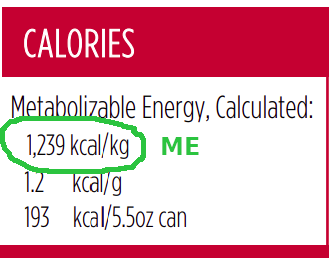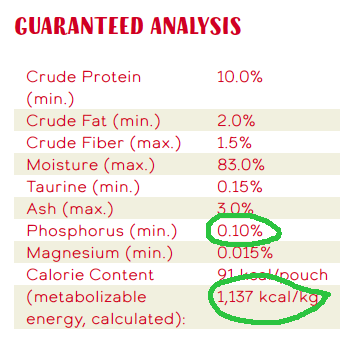
A typical can of cat food is mostly water with some meat and other ingredients in it. If you were to remove the water, imagine what remains as the "dry matter." This is where all the nutrients - phosphorus, protein, etc. - come from, not from the water. And because every cat food has a different amount of water in it, the "dry matter" is different in every food. (Even dry food has some water in it, so you need to figure out the "dry matter" for it too.) For example, if a food is 70% water, then it has 30% dry matter. If it is 85% water, it has 15% dry matter.
When manufacturers provide an "as fed" percentage (what is used in a "guaranteed analysis") for a nutrient, that is for the whole can, including the water. But what we really want to know is: what's the percentage of that nurtrient in the dry matter? Because that's where the nutrients come from. The cat consumes all the water in the food whether it is 70% water or 85% water. When we compare foods to see which one is lower or higher in some nutrient like phosphorus, we need to factor out the water and look at just the dry matter. This is called "dry matter basis."
Every cat food has a different water percentage so a different amount of dry matter. When we compare foods, we have to compare the nurients on the same basis. Figuring out the percentages on a dry matter basis is one way to compare the nutrients in a consistent way. Two different foods that are both 0.2% "as fed" phosphorus may have a different phosphorus content on a dry matter basis. So, your cat will consume more phosphorus from one than the other.
Figuring out the dry matter basis is easy - a simple math problem - if you have the moisture percentage as well as the "as fed" percentage of the nutrient. Or you can just use the calculator above and enter the two percentages - but here is the equation:
% DMB =
Ingredient %
(100 - Moisture %)
x 100
Look at the example below, which is part of a cat food's nutrient profile. To find the % DMB for phosphorus, plug in 73.10% for the moisture and 0.48% for the ingredient %. You get 1.78% DMB.

Another way to compare the nutrients in cat foods is to use a calorie basis, not % DMB (which is based on the weight of the food or the amount of it you feed). For minerals like phosphorus, we sometimes look at the number of mg (millograms) of the mineral per 100 calories fed - or mg/100kcal..
Why would we need a different way than % DMB to compare foods? The main reason is that while % DMB is a great way to compare two foods, it's not a great way to see how much of some nutrient your cat actually consumes from each food. That's because cat foods can have very different calorie amounts even if they weigh the same. In particular, fat is much more calorie-dense than protein or carbs, so a food that is high in fat will be much higher in calories (more "calorie-dense") than a food that is low in fat.
In other words: your cat will need to eat less of a higher calorie food than one that is lower in calories. Calories are calories. If my cat needs 200 calories/day, it doesn't matter how much food it is - that may be one can of a high calorie food or two cans of a low calorie food.
Here's the math to calculate the mg/100kcal. You need the Ingredient % and the ME (Metabolizable Energy) in kcal/kg:
mg/100kcal =
Ingredient %
ME kcal/kg
x 1,000,000
Let's illustrate with an (extreme) example comparing the phosphorus content of two very different foods. (These are real foods.) "Food H" is much higher in calories (higher in fat) than "Food L," so you'll need to feed more cans of "Food L" (approximately twice as many cans) than you would of "Food H" to provide your cat with the same amount of calories.
| Food name | Phos % As Fed |
Moisture | Metabolizable Energy |
Phos % DMB |
Phos mg/100kcal |
|---|---|---|---|---|---|
| Food L | 0.12% | 84.5% | 622 kcal/kg | 0.77% | 193 |
| Food H | 0.18% | 76.4% | 1292 kcal/kg | 0.76% | 139 |
Notice first that Food L is has a lower "as fed" phosphorus than food H - 0.12% instead of 0.18%. But Food L has a lot more moisture in it (84.5% vs. 76.4%) - so that 0.12% is more diluted with water. And indeed, we see that Food L has almost exactly the same phosphorus on a dry matter basis, 0.77% DMB, as Food H which is 0.76% DMB.
But...look at the mg/100kcal: Food L is much higher - 193mg/100kcal instead of just 139mg/100kcal for Food H. So if you looked at the "as fed" percentages, you would have thought "Food L" is lower!" If you had looked at the % DMB, you would have thought they were about the same. But if you look at the mg/100kcal, you see that your cat will consume much less phosphorus from Food H even though the % DMB is almost the same.
This is an extreme example to illustrate a point (though these are real foods). Usually there is not quite as much difference between % DMB and mg/100kcal as there is with these two, but sometimes there is.
Here's an example where the ME (Metabolizable Energy) is 1,239 kcal/kg (calories per kg). If you plug that in along with the "as fed" phosphorus above of 0.48%, you get 387mg/100kcal. (That's quite high.)
Although you'll rarely find the mineral percentages on a food label, you'll almost always fine the ME listed - the number of calories by weight - on the label of the can or bag. Sometimes the units are different and you have to convert them to kcal/kg.

Besides needing to factor out the water using % DMB or mg/100kcal to compare the nutrient amounts on the same basis, you also need to understand whether the percentages are "typical" (averages) or whether they are "guaranteed analysis" (minimums or maximums). The typical analysis is greatly preferred and considered more accurate. Some food companies provide this, but many don't. Instead, sometimes they provide only a "guaranteed analysis" - which is largely a US FDA requirement on a food label (e.g. in a human food, you want to make sure the food isn't all fat and no protein).
Guaranteed analysis percentages are minimums or maximums (usually minimums except for the moisture). They are less useful than typical analysis numbers, but you can still use them for minerals like phosphorus. Several manufacturers say that their maximum will never be more than 50% of the minimum. So if you want to guess at an average, you could guess in between - about 25% above the minimum.
Look at the guaranteed analysis example below; unlike the first example above, it is labeled "Guaranteed Analysis" not "Typical Analysis." The moisture is 83% and the phosphorus is 0.10% (minimum). If you want to compare the phosphorus to the more accurate typical analysis (average), let's multiple that 0.10% by 1.25 (25% higher) - that gives us an "as fed" phosphorus of 0.125% (typical/average).
Using the calculators above, you get a phosphorus of 0.74% DMB (typical/average) or (with the ME of 1,137 kcal/kg) and a mg/100kcal of 110mg/100kcal .

All the calories in food (100%) come three things: protein, fat, and carbs. When you consider how much protein, fat, or carbs your pet may consume, it may be more useful to consider the percent of the calories from it, rather than something like dry matter basis, which is based on the weight of the food. Calories are calories. If your cat needs say 200 calories a day to maintain weight, it doesn't matter how much the food weighs (dry matter basis) - you could feed 200 calories from a high protein, low fat food or 200 calories from a low protein, high fat food (which would be less food - less weight - than a high protein, low fat food).
These three percentages of each of protein, fat, and carbs must add up to 100%. If you have a food that is 40% calories from protein, 50% from fat, and 10% from carbs...if you want to consider a higher protein food - say one that is 50% of calories from protein, then you have to reduce the fat and/or carbs - the remaining 50% has to come from fat and carbs. All add up to 100%.
Of the three, fat is about twice as dense in calories as protein or carbs. So you can't use something like "as fed" or dry matter basis percentages to compare foods very intuitively. A food that is 8% protein, 8% fat is going to have a lot more calories from fat than from protein. If you use the ME profile instead, it makes more sense, once you start thinking in terms of calories.
Below is an example of two foods with the same dry matter basis of protein. But as you can see, they have different percentages of calories from protein.
| ME Profile | ||||
|---|---|---|---|---|
| Food name | Protein % DMB |
Protein % of calories |
Fat % of calories |
Carbs % of calories |
| Food A | 42% | 37% | 34% | 29% |
| Food B | 42.1% | 27% | 66% | 7% |
You can see that Food A and Food B (these are real foods) have almost exactly the same protein on a dry matter basis. But Food A (low in fat) has 37% of calories from protein, whereas Food B (much higher in fat and much higher in calories) provides only 27% of calories from protein. Your cat will need to eat a lot less of Food B than Food A to take in the same amount of daily calories. That's why the 27% of calories of Food B indicates that your cat will consume a lot less protein from it than from Food A...even though they basically have the same dry matter basis of protein.